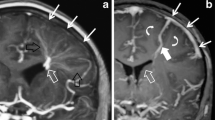Abstract
Objective
Venous hypertension is emerging as a significant contributor to intracranial pressure in children with syndromic craniosysnostosis. This is associated with jugular foramen stenosis or atresia and with the development of collateral emissary veins. We demonstrate how computed tomography venography can document the prevalence of these emissary veins and how their visualisation plays an important role in operative planning.
Materials and methods
Patients with known syndromic craniosynostosis underwent computed tomography venography as part of their routine pre-operative evaluation. The venous drainage pattern was examined in these patients, with a special note of the presence of abnormal venous pathways.
Results
Eleven patients were recruited into the study from ages 3 months to 22 years. All had a diagnosis of syndromic craniosynostosis with six Crouzon’s, four Pfeiffer’s and one patient with Crouzon’s and acanthosis nigricans. Nine of 11 patients had demonstrable evidences of transosseous venous drainage through an identifiable abnormal emissary vein. Four of 11 had a transosseous route as the main mechanism of drainage for the cerebral venous system.
Conclusions
Patients with syndromic craniosynostosis often demonstrate abnormal venous anatomy, which can have serious consequences on craniofacial surgery, especially when a posterior decompression is being considered. Based on these findings, the authors assert that those children with some syndromic craniosynostosis being considered for surgery should undergo venographic studies as part of their pre-operative evaluation.




Similar content being viewed by others
References
Al-Otibi M, Jea A, Kulkarni AV (2007) Detection of important venous collaterals by computed tomography venogram in multisutural synostosis. Case report and review of the literature. J Neurosurg 107(6 Suppl):508–510
Anderson PJ, Harkness WJ, Taylor W, Jones BM, Hayward RD (1997) Anomalous venous drainage in a case of non-syndromic craniosynostosis. Childs Nerv Syst 13(2):97–100
Britto JA, Chan JC, Evans RD, Hayward RD, Thorogood P, Jones BM (1998) Fibroblast growth factor receptors are expressed in craniosynostotic sutures. Plast Reconstr Surg 101(2):540–543
Casey SO, Alberico RA, Patel M, Jimenez JM, Ozsvath RR, Maguire WM, Taylor ML (1996) Cerebral CT venography. Radiology 198(1):163–170
de Oliveira E, Rhoton AL, Peace D (1985) Microsurgical anatomy of the region of the foramen magnum. Surg Neurol 24(3):293–352
Gray JL, Kang SS, Zenni GC, Kim DU, Kim PI, Burgess WH, Drohan W, Winkles JA, Haudenschild CC, Greisler HP (1994) FGF-1 affixation stimulates ePTFE endothelialization without intimal hyperplasia. J Surg Res 57(5):596–612
Martinez-Perez D, Vander Woude DL, Barnes PD, Scott RM, Mulliken JB (1996) Jugular foraminal stenosis in Crouzon syndrome. Pediatr Neurosurg 25(5):252–255 (1996 Nov)
Mursch K, Brockmann K, Lang JK, Markakis E, Behnke-Mursch J (1998) Visually evoked potentials in 52 children requiring operative repair of craniosynostosis. Pediatr Neurosurg 29(6):320–323
Okudera T, Huang YP, Ohta T, Yokota A, Nakamura Y, Maehara F, Utsunomiya H, Uemura K, Fukasawa H (1994) Development of posterior fossa dural sinuses, emissary veins, and jugular bulb: morphological and radiologic study. Am J Neuroradiol 15(10):1871–1883
Ozsvath RR, Casey SO, Lustrin ES, Alberico RA, Hassankhani A, Patel M (1997) Cerebral venography: comparison of CT and MR projection venography. Am J Roentgenol 169(6):1699–1707
Robson CD, Mulliken JB, Robertson RL, Proctor MR, Steinberger D, Barnes PD, McFarren A, Müller U, Zurakowski D (2000) Prominent basal emissary foramina in syndromic craniosynostosis: correlation with phenotypic and molecular diagnoses. Am J Neuroradiol 21(9):1707–1717
Rollins N, Booth T, Shapiro K (2000) MR venography in children with complex craniosynostosis. Pediatr Neurosurg 32(6):308–315
Rollins N, Ison C, Booth T, Chia J (2005) MR venography in the pediatric patient. Am J Neuroradiol 26(1):50–55
Sandberg DI, Navarro R, Blanch J, Ragheb J (2007) Anomalous venous drainage preventing safe posterior fossa decompression in patients with chiari malformation type I and multisutural craniosynostosis. Report of two cases and review of the literature. J Neurosurg 106(6 Suppl):490–494
Taylor GA (1992) Intracranial venous system in the newborn: evaluation of normal anatomy and flow characteristics with color Doppler US. Radiology 183(2):449–452
Taylor WJ, Hayward RD, Lasjaunias P, Britto JA, Thompson DN, Jones BM, Evans RD (2001) Enigma of raised intracranial pressure in patients with complex craniosynostosis: the role of abnormal intracranial venous drainage. J Neurosurg 94(3):377–385
Thomas M, Barker N (2008) Dose-optimised 3D CT evaluation. Toshiba VISIONS J 12:54–61
Thompson DN, Hayward RD, Harkness WJ, Bingham RM, Jones BM (1995) Lessons from a case of kleeblattschädel. Case report. J Neurosurg 82(6):1071–1074
Wetzel SG, Kirsch E, Stock KW, Kolbe M, Kaim A, Radue EW (1999) Cerebral veins: comparative study of CT venography with intraarterial digital subtraction angiography. Am J Neuroradiol 20(2):249–255
Widjaja E, Shroff M, Blaser S, Laughlin S, Raybaud C (2006) 2D time-of-flight MR venography in neonates: anatomy and pitfalls. Am J Neuroradiol 27(9):1913–1918
Author information
Authors and Affiliations
Corresponding author
Rights and permissions
About this article
Cite this article
Jeevan, D.S., Anlsow, P. & Jayamohan, J. Abnormal venous drainage in syndromic craniosynostosis and the role of CT venography. Childs Nerv Syst 24, 1413–1420 (2008). https://doi.org/10.1007/s00381-008-0667-8
Received:
Published:
Issue Date:
DOI: https://doi.org/10.1007/s00381-008-0667-8




